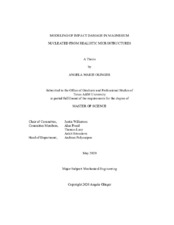| dc.contributor.advisor | Wilkerson, Justin | |
| dc.creator | Olinger, Angela Marie | |
| dc.date.accessioned | 2021-01-06T19:02:20Z | |
| dc.date.available | 2022-05-01T07:12:28Z | |
| dc.date.created | 2020-05 | |
| dc.date.issued | 2020-01-08 | |
| dc.date.submitted | May 2020 | |
| dc.identifier.uri | https://hdl.handle.net/1969.1/191804 | |
| dc.description.abstract | Void growth is known to nucleate from pre-existing defects or particles in a matrix material. When these voids coalesce, ductile failure occurs. Rolled metals can have highly anisotropic particle geometries whose effects are not accurately captured by existing void growth models.
This work seeks to better understand ductile damage that is nucleated from particle geometries present in real microstructures. This work presents calibrated sets of GTN model parameters that match the uniaxial stress response of direct numerical simulations using real, explicitly modeled, particle geometries. Then a method of generating a representative unit cell from a real particle microstructure is presented. This method idealizes real second-phase particles as a distribution of ellipsoids, and generates a representative unit cell from those ellipsoids’ sizes and nearest-neighbor spacings. The representative unit cell is then rotated to obtain a unit cell for a certain loading direction.
The nearest-neighbor spacing algorithm has limitations for certain particle spacings, and also tends to over-predict the porosity of the original unit cell compared to the original particle distribution. An improved method of spacing estimation is presented using a Voronoi tessellation which more closely reproduces porosity. The unit cells derived from the Voronoi tessellation were compared to direct numerical simulations of their source void distributions, and more closely reproduce the stress strain response of the direct numerical simulations than the nearest neighbor algorithm.
This process allows any microstructure to be idealized as a representative unit cell. These unit cell calculations are much less computationally expensive than directly simulating a real particle distribution, and can be used both for existing microstructures or for microstructural design. | en |
| dc.format.mimetype | application/pdf | |
| dc.language.iso | en | |
| dc.subject | second phase particles | en |
| dc.subject | damage modeling | en |
| dc.subject | magnesium | en |
| dc.title | Modeling of Impact Damage in Magnesium Nucleated from Realistic Microstructures | en |
| dc.type | Thesis | en |
| thesis.degree.department | Mechanical Engineering | en |
| thesis.degree.discipline | Mechanical Engineering | en |
| thesis.degree.grantor | Texas A&M University | en |
| thesis.degree.name | Master of Science | en |
| thesis.degree.level | Masters | en |
| dc.contributor.committeeMember | Freed, Alan | |
| dc.contributor.committeeMember | Lacy, Thomas | |
| dc.contributor.committeeMember | Srivastava, Ankit | |
| dc.type.material | text | en |
| dc.date.updated | 2021-01-06T19:02:21Z | |
| local.embargo.terms | 2022-05-01 | |
| local.etdauthor.orcid | 0000-0001-6588-8918 | |


